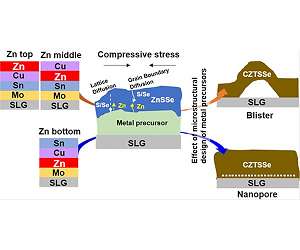Solar panels aren’t just for rooftops anymore – some buildings even have these power-generating structures all over their facades. But as more buildings and public spaces incorporate photovoltaic technologies, their monotonous black color could leave onlookers underwhelmed. Now, researchers reporting in ACS Nano have created solar panels that take on colorful hues while producing energy nearly as efficiently as traditional ones.
Solar panels are typically a deep black color because their job is to absorb light, whereas a red car looks red because the finish reflects red light instead of absorbing it. Most attempts to give these devices color, then, will decrease their ability to absorb light and generate power. One alternative is to use structural sources of color that take advantage of microscopic shapes to only reflect a very narrow, selective portion of light, like the scales on butterfly wings.
However, previous technologies attempting to incorporate structural color gave panels an undesirable iridescence or were expensive to implement at a large scale. So, Tao Ma, Ruzhu Wang, and colleagues wanted to develop a way of giving solar panels color using a structural material that would be easy and inexpensive to apply, and that would maintain their ability to produce energy efficiently.
The team sprayed a thin layer of a material called a photonic glass onto the surfaces of solar cells. The glass was made of a thin, disorderly layer of dielectric microscopic zinc sulfide spheres. Although most light could pass through the photonic glass, selective colors were reflected back based on the sizes of the spheres.
Using this approach, the researchers created solar panels that took on blue, green and purple hues while only dropping the efficiency of power generation from 22.6% to 21.5%. They also found that solar panels manufactured with this photonic glass layer maintained their color and performance during standard durability tests, and that the fabrication could be scaled up. The researchers plan to explore ways to make the colors more saturated, as well as methods to achieve a wider range of colors.
The authors acknowledge funding from the National Natural Science Foundation of China.
Research Report:High-Efficiency, Mass-Producible, and Colored Solar Photovoltaics Enabled by Self-Assembled Photonic Glass
Related Links
American Chemical Society
All About Solar Energy at SolarDaily.com
|
We need your help. The SpaceDaily news network continues to grow but revenues have never been harder to maintain. With the rise of Ad Blockers, and Facebook – our traditional revenue sources via quality network advertising continues to decline. And unlike so many other news sites, we don’t have a paywall – with those annoying usernames and passwords. Our news coverage takes time and effort to publish 365 days a year. If you find our news sites informative and useful then please consider becoming a regular supporter or for now make a one off contribution. |
||
|
SpaceDaily Contributor $5 Billed Once credit card or paypal |
SpaceDaily Monthly Supporter $5 Billed Monthly paypal only |
|

![]()
Eco-friendly solar cells improve efficiency by resolving defects
Daegu, South Korea (SPX) Aug 15, 2022
The DGIST (President Kuk Yang) Thin Film Solar Cell Research Center (Chairman Gang Jin-gyu) worked with Professor Kim Se-yoon of the Department of New Material Engineering at Kyungnam University (President Park Jae-gyu) to investigate the cause of pore formation, a problem in CZTS thin-film solar cells, which are eco-friendly general-purpose thin-film solar cells. It was announced on the 12th (Tuesday) that it developed a technology to overcome this problem.
“Solar cells,” which generate electrici … read more
